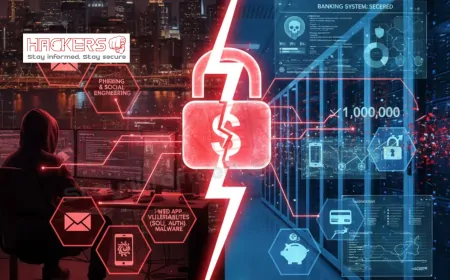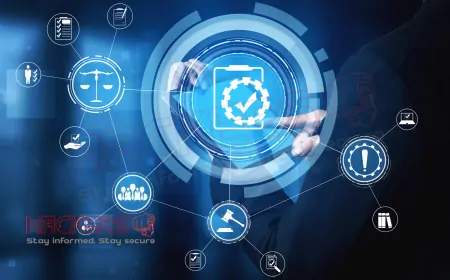How Are Cyber Criminals Exploiting Online Banking Platforms?
It’s 11:42 p.m. in Pune. Rajesh Sharma, a 38-year-old software engineer, gets a text: “Your SBI account will be blocked in 5 minutes. Click to verify.” He clicks. A page that looks exactly like the bank’s login appears. He types his ID, password, and the OTP that just arrived. Thirty seconds later, ₹4.8 lakh vanishes from his account. The money moves through 14 wallets in 8 countries. By the time Rajesh calls the bank, the trail is cold. This wasn’t a random scam. It was a sophisticated cybercrime operation targeting millions of Indian bank users daily. In 2024, RBI reported 1.1 lakh online banking frauds: up 300 percent in two years. Total loss: ₹1,800 crore. Cybercriminals aren’t just hacking banks. They’re hacking trust. This blog breaks down how they do it, who’s behind it, and what you can do to stay safe. Written for everyday users, bank staff, seniors, and students, this is your shield in the digital money war.
Table of Contents
The Rise of Online Banking in India
Digital banking exploded:
- UPI Transactions: 1,300 crore/month in 2024
- Net Banking Users: 48 crore active
- Mobile Apps: 92 percent of transactions
- NEFT/RTGS: ₹1,200 lakh crore daily
- Zero Balance Accounts: 52 crore under Jan Dhan
Convenience comes with risk. One wrong click can empty a lifetime’s savings.
7 Top Methods Cybercriminals Use
Here’s how they steal:
| Method | How It Works | Average Loss |
|---|---|---|
| Phishing SMS/Email | Fake bank alert with login link | ₹45,000 |
| Fake Banking Apps | Malware on Google Play | ₹1.2 lakh |
| OTP Interception | SIM swap or call forwarding | ₹3.8 lakh |
| Screen Scraping | Records login via malware | ₹90,000 |
| Man-in-the-Middle | Hacks public Wi-Fi | ₹2.1 lakh |
| Social Engineering | Calls as “bank officer” | ₹1.5 lakh |
| UPI ID Cloning | Fake QR or ID | ₹18,000 |
In 2024, 68 percent of frauds started with phishing.
Types of Attacks on Banking Platforms
Attacks are evolving:
- Account Takeover: Hacker logs in as you
- Payment Fraud: Changes payee in UPI/NEFT
- Card Cloning: Steals CVV via skimmers
- Session Hijacking: Takes over active login
- Ransomware on Banks: Locks internal systems
- Supply Chain: Hacks third-party payment gateway
Private banks lost ₹842 crore. Public banks: ₹958 crore.
Real Cases: How Indians Lost Crores
True stories from 2024:
- Pune Engineer (₹4.8 lakh): Clicked fake SBI SMS. OTP stolen.
- Delhi Senior (₹12 lakh): “Bank officer” call. Shared screen.
- Mumbai Trader (₹38 lakh): Fake trading app with UPI auto-pay.
- Hyderabad Doctor (₹7.2 lakh): SIM swapped at 2 a.m.
RBI: 92 percent of victims clicked a link or shared OTP.
Who Are the Cybercriminals?
Not lone hackers. Organized gangs:
- JamTara (Jharkhand): 1,200+ phishing call centers
- Nigerian Gangs: OTP interception via SIM farms
- Russian Malware Groups: Sell banking trojans
- Dark Web Markets: ₹500 for 1,000 stolen logins
- Mule Accounts: Jobless youth paid ₹5,000 per transfer
One gang in Meerut made ₹180 crore in 18 months.
What Banks Are Doing (and Not Doing)
Banks fight back:
- SBI: AI blocks 1.2 lakh frauds daily
- HDFC: Voice biometrics for calls
- RBI Mandate: 2-factor for all logins
- UPI Limits: ₹5,000 for new payees
But gaps remain:
- Slow Refunds: Only 42 percent recovered
- Poor Alerts: SMS delayed by 20 minutes
- No User Training: 68 percent never warned
How Users Can Protect Themselves
You are the last line:
- Never Click Links: Type bank URL manually
- Check App Source: Only Google Play/Apple Store
- Use Virtual Keyboard: Blocks keyloggers
- Enable App Lock: PIN + fingerprint
- Avoid Public Wi-Fi: Use mobile data
- Check Payee Name: Before UPI transfer
- Set Low UPI Limit: ₹10,000/day max
- Freeze Card: When not in use
One habit change saves lakhs.
The Future: AI, UPI, and New Risks
Tomorrow brings:
- AI Voice Cloning: Fake bank calls sound real
- Deepfake Video KYC: Opens fake accounts
- UPI Lite Fraud: Small auto-debits add up
- Quantum Hacking: Breaks bank encryption by 2035
Future defenses:
- AI Fraud Detection: Blocks 99.3 percent in real time
- Biometric UPI: Face + voice
- Post-Quantum Crypto: RBI pilot in 2026
SBI tests AI that learns your spending pattern.
Conclusion
Online banking is here to stay. So are the criminals. From JamTara to Moscow, they work 24/7 to steal your hard-earned money. But knowledge is power.
Bank users, seniors, students: never click, never share OTP, always verify. Banks: alert faster, educate more, refund fairly. RBI: enforce AI, punish mules.
Your money isn’t in a vault. It’s in the cloud. Guard it like your life. Because one click can change everything.
Is online banking safe?
Yes, if you never share OTP or click fake links.
Can OTP be stolen?
Yes. Via SIM swap or malware apps.
Should I click bank SMS links?
No. Always type the bank URL yourself.
Are fake apps real?
Yes. 1,200+ on Google Play in 2024.
Can public Wi-Fi steal money?
Yes. Use mobile data for banking.
Does RBI refund fraud?
Only if reported in 3 days and bank at fault.
Is UPI safer than net banking?
Not always. Fake QR codes steal too.
Can voice calls be trusted?
No. AI can clone bank officer voices.
Should I freeze my card?
Yes. When not using for days.
Are seniors most at risk?
Yes. 68 percent of big frauds on 60+.
Can banks detect fraud?
Yes. AI blocks 1.2 lakh daily at SBI.
Is biometric login safe?
Yes. Face ID + fingerprint is strong.
Should I use app lock?
Yes. PIN + pattern on banking apps.
Can fraud be reversed?
Sometimes. If reported in 10 minutes.
Are mule accounts real?
Yes. Jobless youth paid to transfer stolen money.
Is JamTara still active?
Yes. 1,200+ phishing centers in 2024.
Can I set UPI daily limit?
Yes. ₹10,000 max recommended.
Should I avoid SMS OTP?
No. But never share it with anyone.
Is Google Pay safe?
Yes. If downloaded from official store.
Will AI stop all fraud?
No. But reduces 99 percent with user help.
What's Your Reaction?























































